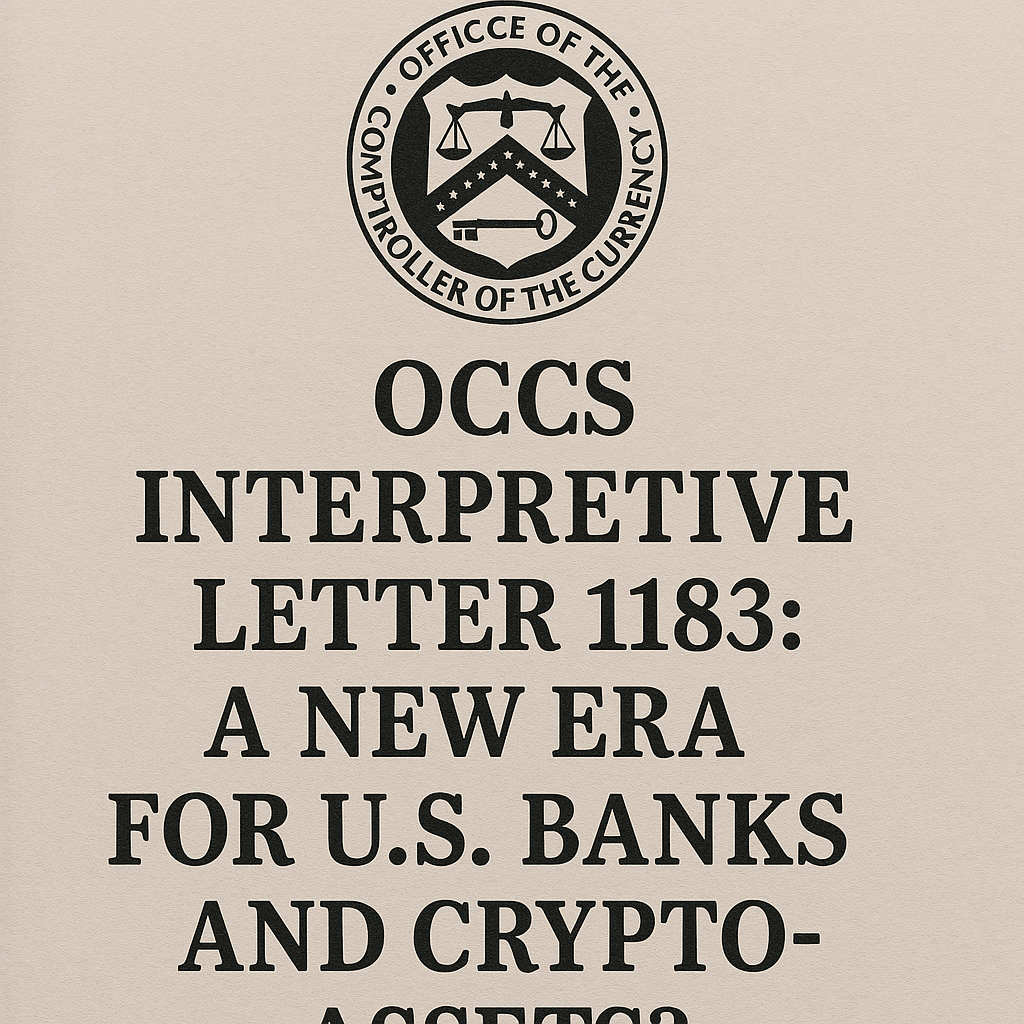OCC’s Interpretive Letter 1183: A New Era for U.S. Banks and Crypto-Assets?

On March 7, 2025, the Office of the Comptroller of the Currency (OCC) issued Interpretive Letter 1183 (the “Interpretive Letter”), reaffirming that national banks and Federal Savings Associations (FSAs) are permitted to engage in crypto-asset custody, distributed ledger activities, and stablecoin-related services. This letter signals a shift in regulatory stance as the OCC acknowledges the increasing maturity of the crypto sector.
This marks a pivotal moment in how U.S. banks may interact with digital assets, but it does not provide a blanket approval for unrestricted crypto engagement. Instead, it aligns with broader regulatory efforts to define a clearer compliance framework for banks operating in the crypto space.
Regulatory Shift: From Caution to Reaffirmation
The Biden administration initially took a restrictive stance on banks engaging with crypto-assets. On January 3, 2023, the OCC, Federal Reserve (Fed), and Federal Deposit Insurance Corporation (FDIC) issued a joint statement emphasizing the risks associated with crypto-assets and discouraging national banks from participating in certain high-risk crypto activities. This marked a notable shift toward regulatory caution following the failures of several crypto-exposed banks earlier that year.
Now, under the new administration, with Interpretive Letter 1183, the OCC has reaffirmed that these services are legally permissible, provided banks demonstrate robust risk controls. This represents a change in regulatory tone—from discouragement to conditional approval, signalling that U.S. banks can engage with digital assets under appropriate safeguards.
OCC’s Active Interpretive Letters on Crypto-Assets
Beyond the Interpretive Letter, the OCC has previously issued three key interpretive letters that remain highly relevant to banks engaging with digital assets. These letters, which are also emphasized in the Interpretive Letter, include:
- OCC Interpretive Letter 1170 (July 2020) – Authorizing banks to provide cryptocurrency custody services.
- OCC Interpretive Letter 1172 (September 2020) – Permitting banks to hold stablecoin reserves, provided they are backed 1:1 by fiat currency.
- OCC Interpretive Letter 1174 (January 2021) – Allowing banks to participate in blockchain networks and use stablecoins for payments.
Key Takeaways from the OCC’s Crypto Interpretive Letters
- OCC Interpretive Letter 1170 – Crypto Custody
This letter affirmed that national banks and FSAs can provide crypto custody services, provided they implement robust risk management controls. Banks engaging in custody must:
- Establish comprehensive policies and procedures tailored to crypto custody.
- Maintain strong operational controls, including dual control procedures and segregation of assets.
- Align new crypto services with sound risk management and existing OCC compliance expectations.
- OCC Interpretive Letter 1172 – Stablecoin Reserves
This letter clarified that banks can hold stablecoin reserves, but only under strict conditions:
- The stablecoin must be fully backed 1:1 by a single fiat currency.
- Banks must verify reserve balances daily to ensure they meet or exceed the issuer’s outstanding stablecoins.
- Banks must comply with AML/KYC requirements under the Bank Secrecy Act (BSA) and the USA PATRIOT Act.
- OCC Interpretive Letter 1174 – Blockchain and Payments
This letter confirmed that banks can use blockchain networks and stablecoins to facilitate payments. The OCC emphasized that:
- Banks acting as blockchain nodes must ensure secure and compliant participation.
- Banks must identify and verify transacting parties, including those using unhosted wallets.
- The use of stablecoins in payment systems is permissible, provided compliance with AML regulations is ensured.
Implication of Letter 1183 for Banks and the Future of Crypto Adoption in the US
The Interpretive Letter does not mean banks now have unrestricted access to crypto-assets. It reinforces banks’ ability to engage with crypto and reflects the U.S.’s positive stance on digital assets— as highlighted in The Crypto Compliance Report Q1 2025— however, significant regulatory uncertainty remains. Key regulatory gaps still need to be addressed, including:
- Stablecoin Legislation – The U.S. Congress continues to debate federal laws governing stablecoins, leaving regulatory uncertainty for banks and issuers.
- Clarity on DeFi and Unhosted Wallets – Existing U.S. regulations provide little guidance on how banks can interact with decentralized finance platforms and unhosted wallets.
- State-Level Inconsistencies – Regulatory requirements vary across states, with jurisdictions like New York imposing stricter crypto compliance rules than the OCC’s federal framework.



